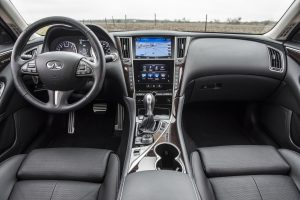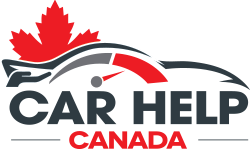By Shari Prymak
2016 Infiniti Q50 - Though a competent sport sedan, the Q50 hasn’t exactly moved the bar forward in the same way that its predecessors, the G35 and G37, did years ago. In a segment as competitive as the entry-level luxury sedan, being merely good isn’t enough, which is why Infiniti has revamped the Q50 with a range of improvements including a tweaked chassis, standard all-wheel drive, and a new range of engines.
Both inside and out, the Q50 lacks the design flair and high-level ambiance that you’d find in its fancy German rivals. Still, it’s quite a tasteful design, and the cabin materials appear to be mostly high quality. Initially, the interior comes off as a bit mishmash with its array of buttons, drive modes, and multiple display screens. Fortunately, most of the controls are fairly user-friendly. The seats too are quite comfortable, and the available large metal paddle-shifters behind the steering wheel are a nice sporty touch.
The Q50 is a comfortable long-distance cruiser with decent ride quality and a quiet cabin. Drive it with a little enthusiasm, however, and it becomes evident that it’s tuned for the sporty side of the spectrum. The optional adaptive suspension and steer-by-wire Direct Adaptive Steering give the Q50 a nice turn-in and agile feel that contribute to solid handling. It doesn’t feel quite on the same level as a BMW 340i or Cadillac ATS, but it’s certainly not far off.

In any case, the part that impresses the most is the straight-line performance. My Red Sport 400 test car had the optional 3.0L, twin-turbo, V6 engine. It pumps out a class-leading 400 horsepower, which is a bit excessive for this segment, but still hugely enjoyable if pure speed and an adrenaline rush are what you’re after. The sweet spot in the range, however, might just be the detuned version of this engine, the 3.0T, which still produces a more than adequate 300 horsepower. With a starting MSRP of $45,900, it’s also significantly cheaper than the Red Sport or the nearly as quick Hybrid models, which go for $54,600 and $56,400 respectively.
The version I would skip is the base lease special 2.0T, which uses a Mercedes-designed, turbocharged 4-cylinder engine. It’s only two grand cheaper, and marginally more efficient, than the equivalent 3.0T model, which isn’t enough to make up for its meager 208 horsepower, not to mention questionable long-term reliability brought on by its Mercedes roots. If I wanted the costly German luxury car experience, I’d just go with a BMW 3-Series or, indeed, a Mercedes C-Class. Part of the appeal of an Infiniti is its Japanese-backed reputation for strong long-term reliability, which is why I’d stick with the Infiniti-designed V6 engines.
If you’re looking to buy an entry-level luxury sedan, there’s no doubt that you’re spoiled for choice. The Lexus IS, Acura TLX, and BMW 3-Series are regular favorites, and the Jaguar XE, Audi A4, and Mercedes C-Class are all compelling as well. Each one of them may offer a little more here and there in terms of sportiness, luxury, or just sheer desirability. The Q50, however, offers a fine blend of sports car thrust and premium features at a reasonable price. If you’re looking for a value-packed sport sedan, it’s a fine choice.

